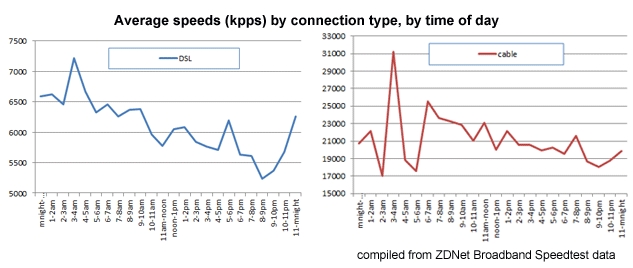Up to speed: sunset slowdown

Addicted gamers know it: the best time to jump online is between 2 and 3am. After that, things start to slow down a bit. In fact, by evening time, they've slowed down quite a lot.
It will come as no surprise to many that the internet is slower at certain times of the day. When we all jump online, we choke the backhaul links and the cable access networks. The latest analysis of data from the ZDNet Broadband Speedtest demonstrates the extent of the slowdown.
These results are based on 174,000 records, collected from Australian users of the Speedtest during April and May this year. Of those, about 35,000 were on cable and 90,000 were home users on DSL. The remainder were on DSL at work, on wireless, on fibre or not sure.
Across and entire day, the average speed was 5.9Mbps for DSL home users and 20.5Mbps for those on cable. As you can see, there's a clear slide in speeds from the overnight peaks, reaching a trough between 8 and 9pm for those on DSL and between 9 and 10pm on cable — perhaps, with more TV to choose from, cablers jump online a little later.

(Credit: Phil Dobbie/ZDNet Australia)
Sadly, we don't have enough data yet to do a meaningful comparison by provider — but we will aggregate the data over coming months to see whether one ISP slows down more than another. However, we do know that, in the worst hour, speeds are 12 per cent slower than the average across the day and more than 20 per cent slower than the fastest hour.
Last month, we discussed how some ISPs seemed to cope better with peak Easter holiday demand than others. Not coping with a school holiday is one thing — it's hard to defend a network that struggles to deal with a daily peak. Remember, the 12 per cent drop is an average across all providers, so it's likely that it'd be more noticeable with certain ISPs.
The issue for ISPs is that this daily peak will become even more pronounced as we chew up bandwidth through connected TVs and other forms of video download. And, it's in the evening speeds where we'll see these effects first.